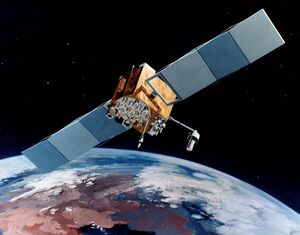Engineering:USA-262
 A Block IIF GPS satellite | |
| Mission type | Navigation |
|---|---|
| Operator | US Air Force |
| COSPAR ID | 2015-033A[1] |
| SATCAT no. | 40730[1] |
| Mission duration | 12 years (planned) |
| Spacecraft properties | |
| Spacecraft | GPS SVN-72 (IIF-10) |
| Spacecraft type | GPS Block IIF |
| Manufacturer | Boeing |
| Launch mass | 1,630 kilograms (3,590 lb)[2] |
| Start of mission | |
| Launch date | 15 July 2015, 15:36 UTC |
| Rocket | Atlas V 401, AV-055[3] |
| Launch site | Cape Canaveral Air Force Station SLC-41[3] |
| Contractor | ULA |
| Orbital parameters | |
| Reference system | Geocentric |
| Regime | Medium Earth (Semi-synchronous) |
| Perigee altitude | 20,445 km (12,704 mi)[4] |
| Apogee altitude | 20,450 km (12,710 mi)[4] |
| Inclination | 55.00 degrees[4] |
| Period | 728.77 minutes[4] |
| Epoch | 15 July 2015, 21:23:20 UTC |
USA-262, also known as GPS IIF-10, GPS SVN-72 and NAVSTAR 74, is an American navigation satellite which forms part of the Global Positioning System. It was the tenth of twelve Block IIF satellites to be launched.[2]
Launch
Built by Boeing and launched by United Launch Alliance, USA-262 was launched at 15:36 UTC on 15 July 2015, atop an Atlas V 401 carrier rocket, vehicle number AV-055.[3] The launch took place from Space Launch Complex 41 at the Cape Canaveral Air Force Station ,[5] and placed USA-262 directly into semi-synchronous orbit.[4]
Orbit
As of 15 July 2015, USA-262 was in an orbit with a perigee of 20,445 kilometers (12,704 mi), an apogee of 20,450 kilometers (12,710 mi), a period of 728.77 minutes, and 55.00 degrees of inclination to the equator.[4] It is used to broadcast the PRN 08 signal, and operates in slot 3 of plane C of the GPS constellation. The satellite has a design life of 15 years and a mass of 1,630 kilograms (3,590 lb). [2] It is currently in service following commissioning on August 12, 2015.[6]
References
- ↑ 1.0 1.1 "Navstar 74". US National Space Science Data Center. https://nssdc.gsfc.nasa.gov/nmc/spacecraft/display.action?id=2015-033A.
- ↑ 2.0 2.1 2.2 Krebs, Gunter. "GPS-2F (Navstar-2F)". Gunter's Space Page. http://space.skyrocket.de/doc_sdat/navstar-2f.htm.
- ↑ 3.0 3.1 3.2 McDowell, Jonathan. "Launch Log". Jonathan's Space Page. http://planet4589.org/space/log/launchlog.txt.
- ↑ 4.0 4.1 4.2 4.3 4.4 4.5 McDowell, Jonathan. "Satellite Catalog". Jonathan's Space Page. http://planet4589.org/space/log/satcat.txt.
- ↑ McDowell, Jonathan. "Launch List". Launch Vehicle Database. Jonathan's Space Page. http://planet4589.org/space/lvdb/list2.html.
- ↑ "NOTICE ADVISORY TO NAVSTAR USERS (NANU) 2015073". United States Coast Guard. http://www.navcen.uscg.gov/?Do=gpsShowNanu&num=2015073.
 |

